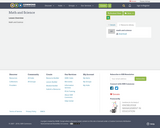
Math and Sceince
- Subject:
- Mathematics
- Material Type:
- Lesson Plan
- Author:
- Ravi kumar
- Date Added:
- 09/27/2016

Math and Sceince

https://cbseit.in/cbse/training/

Coins for College is striving to make higher-education affordable and accessible, creating pathways for student success. By building bridges from High School to College, creating innovative tools for student success and providing greater access through scholarships and special initiatives, we are helping students reach their education and career goals.
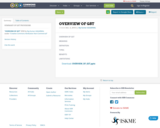
SUMMARY OF GST PROVISIONS
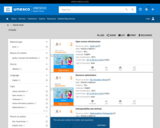
Four-volume curriculum about open access for library schools, from UNESCO:
Module 1: Introduction to Open Access
Contents: Scholarly Communication Process; Open Access: History and Developments; Rights and Licenses; Advocacy for Open Access; Open Access Research Impacts
https://unesdoc.unesco.org/ark:/48223/pf0000231920.locale=en
Module 2: Open Access Infrastructure
Contents: Open Access Repositories; Open Journals; More about Open Approaches
https://unesdoc.unesco.org/ark:/48223/pf0000232204.locale=en
Module 3: Resource Optimization
Contents: Open Access Mandates and Policies; Content Management in Open Access Context; Harvesting and Integration
https://unesdoc.unesco.org/ark:/48223/pf0000232201.locale=en
Module 4: Interoperability and Retrieval
Contents: Resource Description for OA Resources; Interoperability Issues for Open Access; Retrieval of Information for OA Resources
https://unesdoc.unesco.org/ark:/48223/pf0000232199.locale=en

Five-volume curriculum about open access for researchers, from UNESCO:
Module 1: Scholarly Communication
Contents: Introduction to Scholarly Communication; Communicating with Peer Review Journals; Electronic Journals and Databases; Serials Crisis
https://unesdoc.unesco.org/ark:/48223/pf0000231938.locale=en
Module 2: Concepts of Openness and Open Access
Contents: Introduction to Open Access; Routes to Open Access; Networks and Organizations Promotion Open Access; Open Access Mandates and Policies; Open Access Issues and Challenges
https://unesdoc.unesco.org/ark:/48223/pf0000232207.locale=en
Module 3: Intellectual Property Rights
Contents: Understanding Intellectual Property Rights; Copyright; Alternative to a Strict Copyright Regime
https://unesdoc.unesco.org/ark:/48223/pf0000232208.locale=en
Module 4: Research Evaluation Metrics
Contents: Introduction to Research Evaluation Metrics and Related Indicators; Innovations in Measuring Science and Scholarship; Article and Author Level Measurements; Online Citation and Reference Management Tools
https://unesdoc.unesco.org/ark:/48223/pf0000232210.locale=en
Module 5: Sharing Your Work in Open Access
Contents: The Publishing Process; Share Research Results in Open Access
https://unesdoc.unesco.org/ark:/48223/pf0000232211.locale=en

My name is Amit Kumar.
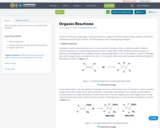
Type of organic chemical reactions are explained with examples.
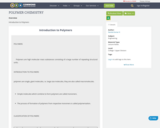
Introduction to Polymers
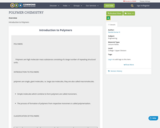
Introduction to Polymers
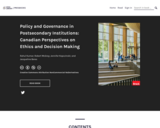
This edition represents the collection of seminal ideas that have shaped the postsecondary institutions in Canada. The chapters in this edition correspond to the animating ideas that are relevant in this era of increased participation of the public in tertiary education. The chapters that have been chosen to present the reader with the salient issues concerning functioning, accountability, policy framework, inter alia, constitute the sessions of a course on post secondary policy and governance offered to adults who either work at or aspire to work at universities and colleges. This text is interactive insofar as it offers stimuli for the engaged student to co-construct knowledge and their own gloss of pertinent issues. This text introduces concepts through various examples and contemporary cases and provides a plethora of resources primarily from Canadian context for further engagement. Finally, it offers an activity, through case studies, for students to play the part of various roles in the postsecondary sector to bring together the ideas explored in the text.

This is an image of Polymorphism in C++ describing the concept of overloading, overriding and virtual concepts.
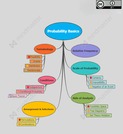
Probability Basics & its branches.As described in mindmap.

This image is describing about various types of perspective and parallel projection in computer graphics.
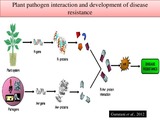
This topic describing the r gene resistance in plant
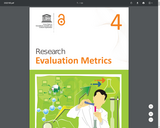
This module dwells on a number of methods (including old and new) available for research evaluation. The module comprises the following four units:
Unit 1. Introduction to Research Evaluation Metrics and Related Indicators.
Unit 2. Innovations in Measuring Science and Scholarship: Analytical Tools and Indicators in Evaluation Scholarship Communications.
Unit 3. Article and Author Level Measurements, and
Unit 4. Online Citation and Reference Management Tools.
Brief overviews of the units are presented below.
Unit 1 encompassed and discussed citation analysis, use of citation-based indicators for research evaluation, common bibliometric indicators, classical bibliometric laws, author level indicators using authors' public profiles, article level metrics using altmetric tools. It is to be noted that author level indicators and article level metrics are new tools for research evaluation. Author level indicators encompasses h index, citations count, i10 index, g index, articles with citation, average citations per article, Eigenfactor score, impact points, and RG score. Article level metrics or altmetrics are based on Twitter, Facebook, Mendeley, CiteULike, and Delicious which have been discussed. All technical terms used in the Unit have been defined.
Unit 2 deals with analytical tools and indicators used in evaluating scholarly communications. The tools covered are The Web of Science, Scopus, Indian Citation Index (ICI), CiteSeerX, Google Scholar and Google Scholar Citations. Among these all the tools except Indian Citation Index (ICI) are international in scope. ICI is not very much known outside India. It is a powerful tool as far Indian scholarly literature is concerned. As Indian journals publish a sizable amount of foreign literature, the tool will be useful for foreign countries as well. The analytical products with journal performance metrics Journal Citation Reports (JCR®) has also been described. In the chapter titled New Platforms for Evaluating Scholarly Communications three websites i.e. SCImago Journal & Country Rank (SJR) [ScimagoJR.com], eigenFACTOR.org, JournalMetrics.com and one software called Publish or Perish (POP) Software have been discussed.
Article and author level measurements have been discussed in Unit 3. Author and researcher identifiers are absolutely essential for searching databases in the WWW because a name like D Singh can harbour a number of names such as Dan Singh, Dhan Singh, Dhyan Singh, Darbara Singh, Daulat Singh, Durlabh Singh and more. The ResearcherID.com, launched by Thomson Reuters, is a web-based global registry of authors and researchers that individualises each and every name. Open Researcher and Contributor ID (ORCID) is also a registry that uniquely identifies an author or researcher. Both have been discussed in this Unit. Article Level Metrics (Altmetrics) has been treated in this Unit with the discussion as to how altmetrics can be measured with Altmetric.com and ImpactStory.org. Altmetrics for Online Journals has also been touched. There are a number of academic social networks of which ResearchGate.net, Academia.edu, GetCited.org, etc. have been discussed. Regional journal networks with bibliometric indicators are also in existence. Two networks of this type such as SciELO – Scientific Electronic Library Online, and Redalyc have been dealt with.
The last unit (Unit 4) is on online citation and reference management tools. The tools discussed are Mendeley, CiteULike, Zotero, Google Scholar Library, and EndNote Basic. The features of all the management tools have been discussed with figures, tables, and text boxes.
This is Module Four of the UNESCO's Open Access Curriculum for Researchers.
Full-Text is available at http://unesdoc.unesco.org/images/0023/002322/232210E.pdf
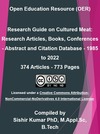
This Book is a Open Education Resource (OER) and is Research Guide on Cultured Meat providing the details of Research Articles, Books, Conferences along with Abstract and Citation Database from the time period of 1985 to 2022.This study resource is a unique resource to gain deeper understanding of research and development relating to cultured meat sector.
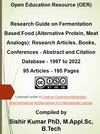
This Book is an Open Education Resource (OER) and is Research Guide on Fermentation Based Food relating to Alternative Protein and Meat analogs or Meat alternatives, providing the details of Research Articles, Books, Conferences along with Abstract and Citation Database from the time period of 1997 to 2022.This study resource is a unique resource to gain deeper understanding of research and development relating to Fermentation Based Food relating to Alternative Protein and Meat alternatives.
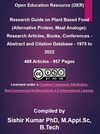
This Book is an Open Education Resource (OER) and is Research Guide on Plant Based Food relating to Alternative Protein and Meat analogs or Meat alternatives, providing the details of Research Articles, Books, Conferences along with Abstract and Citation Database from the time period of 1975 to 2022.This study resource is a unique resource to gain deeper understanding of research and development relating to Plant Based Food relating to Alternative Protein and Meat alternatives.

Social media isa transformedform of traditional method of one way communication. Social media empowers the two way communication between brands and consumers and it enablesthe consumer to make positive as well as negative influence on brand awareness. Many business use social media channels as a marketing tool to promote their products and services to make customers more aware and convince with their brand. The essence of this study is to find out how entrepreneur can seize the moment of using social media networks to hype brand awareness and brand image. Awareness which includes both recall and recognition become the first step for any move toward a successful market strategy. In this paper an attempt is made to know the role of social media on the brand awareness. The finding of the study can be used by the businessman to collective brand awareness through social media.